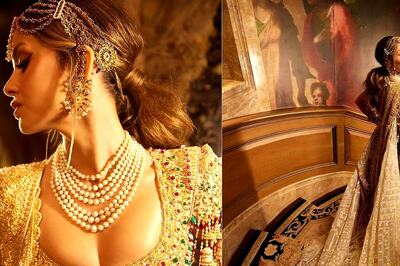
views
Goth Symbols & Their Meanings
Ankh The ankh is the ancient Egyptian symbol for eternal life and looks like a cross with a loop at the top. The symbol became popular among goths in the 1980s, when all things Egyptian were in style within the community. Many goths also wore heavy, Egyptian-inspired makeup, snake jewelry, upper arm bracelets, and haircuts reminiscent of the styles shown in hieroglyphics. The ankh was further popularized by the Sandman comics, in which the character Death was depicted as a goth woman wearing an ankh around her neck.
Pentacle/Pentagram A pentagram is a five-pointed star, and a pentacle is a five-pointed star enclosed in a circle. Both are ancient pagan symbols, and each point of the star represents one of the following elements: earth, air, fire, water, and spirit. It is a symbol of protection, often placed in the home or worn as jewelry. These symbols are frequently used by neopagans and witches, and some goths practice these beliefs. The reversed (or upside-down) pentagram or pentacle is often associated with Satanism. It is a subversion of the traditional shape, in which the point representing the spirit is placed above the four elements. The inverted symbol also resembles a horned goat.
Skulls Skulls were a common motif in medieval and Renaissance art called the “memento mori” (Latin for “Remember you must die”). Since then, they still serve as a symbol of mortality. Many goths see them as both macabre and beautiful, and they frequently appear on jewelry and clothing designs. Animal skulls are also a prominent goth symbol, such as deer, wolves, and other animals associated with dark forest imagery.
Eye of Horus/Eye of Ra The Eye of Horus, or the wedjat, is a symbol of healing and protection from ancient Egypt. It represents the left eye of Horus, the falcon-headed god. If the symbol depicts a right eye, it’s the Eye of Ra, the sun god. This symbol represents both Ra’s protective qualities and his sometimes vengeful spirit. Like the ankh, these ancient Egyptian symbols were also popularized by the goth community in the 80s. Goth icon Siouxsie Sioux was often spotted wearing Eye of Horus-inspired makeup. The symbol also appears on the cover of the Sisters of Mercy album Vision Thing. These symbols also have occult connotations due to the interest in Egyptian symbolism expressed by 19th and 20th-century occultists like Aleister Crowley and Madame Blavatsky.
Inverted Cross In modern times, the upside-down cross is often considered a Satanic or anti-Christian symbol, but it actually has deep roots in Christianity. Also known as the Cross of St. Peter, it references the crucifixion of St. Peter, who was crucified upside down because he didn’t believe he was worthy of dying in the same way as Jesus. Still, when used in gothic fashion, this symbol usually represents a rejection of Christian doctrine. When goths wear the inverted cross, it is typically more of a political statement than a religious one, as it shows the wearer disagrees with imposing Christian values on secular life. This likely began as a response to Ronald Reagan’s “moral majority” campaign. In media, upside-down crosses are often associated with demonic imagery. They often appear in horror movies like The Amityville Horror and The Conjuring. Metal bands like Ghost also use inverted crosses in their iconography.
Rosaries/Crucifixes Some Goths incorporate Christian symbols into their style, even if they don’t follow the religion themselves. They often put a dark spin on Catholic symbols, including the crucifix, rosary, saints’ medals, and Sacred Hearts. This is typically done purely for aesthetics, but some goths enjoy the shock value and campiness that comes with it.
Ravens Ravens (and crows) are mostly associated with the goth subculture due to their symbolism in Gothic literature, where they often represent death, loss, and the supernatural. These associations were cemented by Edgar Allan Poe’s iconic poem, “The Raven.” In modern media, many gothic characters are also named Raven.
Triple Goddess Symbol The Triple Goddess (or triple moon symbol) is another neopagan symbol, often used in Wiccan traditions. The symbol consists of a circle flanked by two crescent moons, representing both the phases of the moon and the unity of the Maiden, the Mother, and the Crone—the 3 aspects of the Goddess. It also represents Hekate, a Greek triple goddess of magic, night, and crossroads. The Triple Goddess symbol is often depicted on jewelry, including rings, necklaces, and headbands. Many people also get the symbol tattooed. Even those who don’t practice a pagan religion often appreciate the symbol as a representation of the divine feminine.
Leviathan Cross The Leviathan Cross, sometimes known as the Brimstone symbol or the Cross of Satan, resembles a double cross on top of an infinity symbol. In the Bible, Leviathan is a giant sea serpent associated with chaos and the devil. In the 1960s, Anton LeVey included the symbol in his Satanic Bible, where Leviathan represented water and the West, symbolizing knowledge surfacing from the depths. Outside of the LeVeyan tradition, this symbol has no Satanic associations. Like the inverted cross, goths may wear the Leviathan Cross as a political or religious statement. In alchemy, this symbol represents sulfur, or brimstone. It also symbolizes the masculine, active principle, the sun, and fire.
Sigil of Lilith The Sigil of Lilith is a powerful symbol associated with Lilith, a female figure from Jewish and Babylonian folklore. Originally the first wife of Adam, Lilith was headstrong and independent, choosing exile from the Garden of Eden. She eventually became a grotesque, demonic mythological figure associated with witchcraft. Her sigil is used by practitioners of many modern witchcraft traditions as a symbol of women’s empowerment. The Sigil of Lilith itself is a recent invention and is depicted by three crosses branching out from the center of a circle that is inscribed with the letters L-I-L-I-T-H. It resembles a modified astrological Saturn symbol. Goth women may use the sigil as a reminder to challenge societal norms and embrace their own strengths and desires.
Spiders Goths may be drawn to spiders due to their associations with darkness, mystery, and the macabre. Spiders often represent both creation and destruction, and the goth aesthetic often embraces duality and the darker aspects of life. Spiders are also misunderstood and can be seen as unsettling or frightening, just like goths.
Ouroboros The Ouroboros is a circular symbol that depicts a snake or dragon eating its own tail. The name means “tail-devourer” in Greek, and it symbolizes the never-ending cycle of death and rebirth. Goths often wear the Ouroboros as jewelry to convey a connection to esoteric knowledge and hidden truth. The Ouroboros can be found across cultures. One of the earliest depictions was found in King Tut’s tomb in Egypt. In Norse mythology, the serpent Jörmungandr encircles the world with its tail in its mouth, and in Hindu iconography, the Ouroboros is part of the foundation of the world.
Triquetra/Trinity Knot The triquetra, or Celtic Trinity Knot, is composed of three interconnected arcs and represents interconnectedness and unity. It may also represent the Holy Trinity, the Triple Goddess, or the earth, sky, and sea. The symbol may be depicted on goth jewelry or fashion for its visual appeal and themes of eternity. Goths who are also pagan may also use the Trinity Knot in their religious practices.
Hexagram A hexagram is a star-shaped figure formed by two intersecting triangles. The symbol has been used in many religions, including Christianity, Judaism, Islam, Hinduism, and Buddhism. Occultist Aleister Crowley also used a form of the hexagram in his Thelema teachings, in which it represented the microcosm mingling with the macrocosm. The hexagram became a goth symbol because of its associations with the occult and symbolism of opposing forces.
Sigil of Lucifer The Sigil of Lucifer is an inverted triangle with sides that extend to form an X with rounded ends, with another X inside the triangle and a V below it. It represents Lucifer in his “light-bearer” aspect and represents knowledge in various Satanic traditions. In LaVey’s Satanic Bible, Lucifer is associated with the East and is a “lord of the air” who brings enlightenment. Luciferianism views Lucifer not as Satan, but as a figure associated with liberation and intellect. The Sigil of Lucifer is used in magical traditions, like Luciferian Wicca, and by those who value intellectual freedom. Like other religious symbols, goths may use the Sigil of Lucifer as a political or religious statement.
Baphomet Baphomet is a winged, goat-headed figure associated with Satanism. Often depicted as androgynous, Baphomet represents the balance between elements in various occult traditions. The Sigil of Baphomet places the figure’s head inside an inverted pentagram, with Hebrew letters spelling out “Leviathan.” It is the official symbol of the Church of Satan. Goths may be drawn to Baphomet as a symbol of rebellion against societal norms, or they may have a fascination with the occult.
Bats Bats are strongly associated with goth subculture because of their connection to darkness, mystery, and the supernatural. Bats are nocturnal creatures, meaning they primarily come out at night. Bats are often featured in Gothic literature as symbols of danger and the macabre, and they’re also closely associated with vampires, like Dracula. Those new to the goth scene are sometimes called “baby bats” as they’re still exploring the subculture and learning their style.
666 Some goths may be drawn to the number 666, which represents the number of the beast in the Bible. Like other controversial religious symbols, goths may adopt this number as an act of rebellion or provocation. The number is also frequently shown in horror movies, which many goths enjoy watching.
Tarot Cards Some tarot card imagery is also associated with the goth subculture. For example, the High Priestess represents spirituality and intuition, so the card is often depicted on goth clothing because of its associations with mystery and finding your own path. The Devil is another popular choice, as the imagery is often associated with Satanic traditions. Like skull imagery, the Death tarot card is also a common goth symbol, representing the need to let go of old ways and embrace change.
Goth Copy-and-Paste Symbols
Copy and paste these symbols for a goth social media bio. If you want to give your Instagram, TikTok, or other social media page a bit of an edge, add some dark, aesthetic symbols to your bio. Simply copy and paste these symbols as they’re listed, or mix and match to create a unique combo. ⁺‧₊˚ ཐི⋆♱⋆ཋྀ ˚₊‧⁺ ‿̩͙⊱༒︎༻♱༺༒︎⊰‿̩͙ ⛧°.⋆༺????༻⋆.°⛧ ✃????꒷꒦ ⛧⃝???? ⫘⫘⫘⫘⫘⫘ .˚⊹. ࣪???? ࣪⊹˚. ⛧°. ⋆????*♰*????⋆. °⛧ ╋━ ✩₊˚.⋆????️⋆⁺₊✧ ⋆˖⁺‧₊☽◯☾₊‧⁺˖⋆ ✞︎????????????????????????????✞︎ ⋆༺????☠︎︎????༻⋆ ✩₊˚.⋆☾????☽⋆⁺₊✧ ♡☠︎︎༒︎✞︎???????? ???? ???? ???? ???? ⁶⁶⁶ ༺♡♱⋆????⋆♱♡༻ ????????ཐི‧⁺˚̣̣̣????༺༒︎༻໒˚̣̣̣⁺‧ཋྀ???????? ⁺‧₊˚ ཐི⋆☥⋆ཋྀ ˚₊‧⁺ ───⋆˖⁺‧₊☽◯☾₊‧⁺˖⋆─── ˚☽˚.⋆ ཐི❤︎ཋྀ ???????????????????? ???? ???? ???? ???? ⁶⁶⁶
Goth Emojis
Play around with different goth emoji combos. There are plenty of dark and edgy emojis you can use to make your username or social media bio more aesthetically pleasing. Try combining these emojis with gothic copy-and-paste symbols, or string a few emojis together to create your own combo. ???? ???? ???? ????️ ????️ ???? ???? ⚰️ ???? ☠️ ????️ ???? ???? ⚔️ ???? ???? ???? ????️????️ ⛓️ ???? ????️ ???? ????⬛ ???? ⌛


















Comments
0 comment